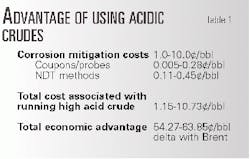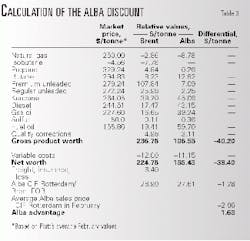Refiners can significantly increase profits by processing discounted high-acid crudes because about 80% of their costs is crude oil.
A full risk-based assessment prior to processing higher levels of naphthenic crudes gives the refiner a better overview of the benefits, costs, and risks associated with running these crudes.
Taking extra corrosion measures into account, the cost advantage of processing high naphthenic acid crudes is 30-50¢/bbl. The discount for processing high-acid Alba crude instead of Brent, is 54-64¢/bbl.
In this article, Nalco/Exxon Energy Chemicals LP, Sugar Land, Tex., uses Alba crude to estimate the refinery costs for corrosion mitigation to process high acid crudes. Alba, produced by Chevron Corp., San Francisco, in the North Sea, has a total acid number (TAN) of 1.4 mg KOH/g.
Table 1 shows the total cost associated with running high acid crudes, typically those with a TAN greater than 1 mg KOH/g, in a refinery. The risk of corrosion in refineries increases with increasing TAN of crude.1-5
Traditionally, refiners have been reluctant to process crude oils containing high TAN. Most refineries blend their crude oil to a TAN of 0.5 mg KOH/g or lower to minimize corrosion problems.
In the past several years, refiners have become more interested in processing high acid crudes because of their attractive market prices.
Fig. 1 summarizes the production rate of high acid crudes worldwide, which has been increasing, particularly in West Africa. The production rate of high acid crudes in West Africa will be about 12% of the total crude oil produced there by 2005.
Alba refining characteristics
Chevron's Alba field lies in Block 16/26 on the UK Continental Shelf, about 130 miles northeast of Aberdeen.
Alba is an acidic, high-flash, hydrogen-deficient (naphthenic) crude oil. The accompanying box contains a crude assay. Fig. 2 shows the acid profile for this crude. The accompanying box contains a crude assay.
Complex refineries running heavy crudes are ideal for Alba.
The heavy crude has superb blending attributes. It has a low pour point of -35° C. The low pour point of the middle distillate is particularly attractive to refiners whose mid-distillate yield is limited by cold properties. They may blend Alba with more paraffinic crudes to increase the jet and diesel yield.
Refiners may realize higher diesel production by running Alba blended with another crude vs. running the crude alone. Alba is also rich in vacuum gas oil (VGO), making it an economically attractive fluid-catalytic cracking unit (FCCU) and hydrocracker feedstock.
- Naphtha and distillate yield. The naphtha yield is low (<1.3 vol %) but highly reformable with an 83 vol % makeup of naphthenes and aromatics. The middle distillate yield (26.9 vol %) is similar to yields from other heavy crudes.
- Kerosine. The kerosine may be off spec in gravity and smoke point for jet-fuel manufacture in some areas. It has fluidity giveaway, however, which makes it an attractive blendstock to refiners who have jet components with burning-quality giveaway.
- Atmospheric gas oil. Alba's gas oils have excellent cold properties such as pour point, freeze point, and cold-filter plugging point (CFPP). These characteristics are consistent with the naphthenic nature of the crude and allow synergies with other feedstocks with limitations on fluidity.
The cetane index of Alba is low at 42. For European markets, blending with other diesel components with cetane giveaway or cetane improvers is necessary.
Heating oil production and US diesel manufacture are not a problem.
- Vacuum gas oil. At 42.3 vol % VGO recovery, Alba is VGO rich.
The VGO is hydrogen-deficient and nearly wax free. Its sulfur level of 1.13 wt %, while higher than typical North Sea crudes, is much lower than Arab Gulf crudes and Maya, which are as high as 3.5 wt %.
It is suitable for catalytic cracking or hydrocracking but will give somewhat poorer yields than a more paraffinic feedstock. The VGO may also be used for the production of naphthenic lubricants.
- Vacuum residue. Alba has a high-quality vacuum residue with sulfur content, carbon residue, and asphaltenes that are better than other heavy-crude resids. It has moderate levels of nitrogen and metals.
Alba will provide higher quality fuel oil and better visbreaker and coker feed than other heavy crude resids. It is also suitable for industrial asphalt manufacture.
Relative refining values
Alba's acidity and low light-product yield make it better in a mix with other crudes than run pure. Alba usually comprises 10-40% of the crude slate in northwest European refineries.
To define the value of Alba, Nalco/Exxon used a linear program (LP) model to simulate a typical northwest European topping-reforming-visbreaking refinery with an FCCU and alkylation unit sized for 100% Brent blend. The model used 2000 EU product specifications and the average February prices for domestic products.
Refinery fuel and operating costs were based on 20¢/equivalent distillation capacity. The model purchased natural gas for fuel and for isobutane in alkylation.
The model ran 100% Brent blend and 85% Brent/15% Alba. The yields and values for 100% Alba were extrapolated arithmetically from the 100% Brent and 85/15 mix runs (Table 2).
The prevailing market crude price, product prices, and price-quality adjustments determine the relative refining value (Table 3). The difference between the calculated refining value and the actual crude-sales price is the acid discount for Alba (Fig. 3).
This discount averages around 65¢/bbl. The worked example in Table 3 shows an abnormally high acid discount for February of $1.68/bbl.
The average acid discount for North Sea acid crudes is between 30 and 50¢/bbl per whole TAN for crudes above 0.5 mg KOH/g TAN. When heavy crudes are in short supply, for example, as a result of OPEC cuts, the discount is narrower than during times of ample heavy crude supply (Fig. 4).
Besides relative refining value, the decision to refine acidic crudes should include risks and costs.
Refining risks
The severity of the corrosion caused by acidic crudes depends on the type of metallurgy, fluid velocities, amount and type of acids, and crude-slate blends. Although some industry guidelines address these corrosion issues, none provides an unequivocal method to predict corrosion rates.
Refineries interested in running high acid crudes should conduct a risk-based assessment of the refinery areas subject to naphthenic acid attack.
The assessment identifies the areas of potential acid attack and reviews these areas' metallurgies, operating temperatures, velocity characterizations, inspection histories, TAN and sulfur histories, and tankage issues for blending.
It also analyzes the naphthenic acid content of the crude and the crude's effect on the naphthenic acid distribution in crude unit side streams and downstream units.
A comprehensive monitoring program will allow the refinery to run high acid crudes while minimizing capital expenditure and the risk of corrosion failure. Several tools help monitor corrosion in the most vulnerable areas:
- Corrosion coupons.
- Customized corrosion probes with data loggers.
- Corrosion probes equipped with on-line automated system.
- Metal-thickness readings or other non-destructive testing.
- Hydrocarbon analysis for metals.
- TAN, naphthenic acid, and sulfur analysis of the crude oil or side streams.
Refining costs
Corrosion monitoring hardware, inspection tests, chemical treatment, and mechanical upgrades are ways to prepare for processing of higher TAN crude slates. They come at a cost, however.
For a 120,000-b/d unit, the cost of purchasing coupons for an atmospheric distillation column and vacuum unit is 005-0.03¢/bbl for 6-10 coupons. Probes cost 0.04-0.28¢/bbl.
Costs associated with non-destructive testing and metal thickness measurements vary from one refinery to another. Processing high acid crudes may require considerable measurements initially. The number of inspections decreases when the refinery gains confidence in the reliability of inspection results.
The typical initial frequency of ultrasonic measurements on areas susceptible to naphthenic acid corrosion is monthly. It later declines to 6-month intervals. These measurements may require additional scaffolding to reach the more remote locations. One-time initial costs associated with building scaffolding may also be high.
The approximate incremental annual cost of using a certified technician to take ultrasonic measurements is $20,000, or 0.11-0.45¢/bbl of opportunity crude.
The costs of analytical tests for measuring metals content, TAN, naphthenic acid, and sulfur are insignificant when compared to the cost per barrel of high acid crude. Therefore, these costs will not be further discussed.
Early detection of corrosion will allow corrosion mitigation using chemical treatment. Nalco/Exxon has practiced this method of mitigation for more than 20 years.6 7
The cost associated with a chemical treatment is a function of existing metallurgy and operating conditions for the equipment in question.
When two refineries process the same blend of crude oil, corrosion may be observed in one refinery and not in other. Thus, corrosion relates not only to the nature of the crude oils but also to the operational conditions in a refinery.
The cost of corrosion inhibitors for mitigating naphthenic acid corrosion ranges from 1 to 10¢/bbl of high acid crude, depending upon the extent of areas requiring protection and the percentage of naphthenic crude in the crude slate.
If the refinery has a long-term commitment to process high acid crude oil, upgrading metallurgy in susceptible areas of corrosion may be economically feasible. The typical cost of a refinery metallurgy upgrade is $12-20 million, which is a payback period of 2-3 years based on a run rate of 40,000 b/d of the high acid crude in a 120,000 b/d refinery.
High acid crudes may cause other problems in the refinery that need to be taken into consideration:
- Presence of excess organic acids in the crude unit and visbreaker overhead.
- Emulsion problems in the desalter due to the presence of naphthenate compounds.
- Increased fouling in the stationary bed catalysts if the corrosion is not controlled.
There is usually no incremental cost associated with these problems, provided the appropriate corrective action is in place prior to processing the naphthenic crudes at high rates.
References
- Babaian-Kibala, E., and Nugent, M.J., "Naphthenic Acid Corrosion Literature Survey," NACE Conference, Corrosion 99, Paper No. 378, 1999.
- Blanco, F., and Hopkinson, B., "Experience with Naphthenic Acid Corrosion in Refinery Distillation Process Units," Paper No. 99, NACE Annual Conference, March 1983.
- Gutzeit, J., "Naphthenic Acid Corrosion in Oil Refineries," Materials Performance, Vol. 16, No. 10, October 1977, pp. 24-35.
- Craig, H.L., "Naphthenic Acid Corrosion in the Refinery," Paper No. 333, NACE Conference, Florida, March 1995.
- Piehl, R.L., "Naphthenic Acid Corrosion in Crude Distillation Units," Paper No. 196, NACE Annual Conference, March 1987.
- Babian-Kibala, E., et al., "Naphthenic Acid Corrosion in a Refinery Setting," Paper No. 631, NACE Annual Conference, March 1993.
- Babaian-Kibala, E., "Phosphate Ester Inhibitors Solve Naphthenic Acid Corrosion Problems," OGJ, vol. 62, No. 2, 1994, pp. 31- 35.
The authors
Jan Skippins is an area manager with Chevron's Global Crude Trading. She covers the North Sea and West Africa and is team leader of Chevron's North Sea and high acid crude teams. Skippins joined Chevron in 1989 as a product operations scheduler. Since then, she has been a trading analyst and a continuous-quality-improvement consultant. In October 1992, she returned to the trading group as a fuel and feedstock's trader. Skippins holds a BSc from Hatfield Polytechnic, Hatfield, UK, in applied chemistry.
David Johnson is the European marketing manager for the refinery process chemicals division of Nalco/Exxon Energy Chemicals Ltd. He specializes in mitigation of naphthenic acid corrosion in refineries. He has worked in the hydrocarbons industry and corrosion control since 1981. Since that time he has worked in technology, sales, and marketing positions in the UK and Norway. Johnson holds a BA in science at the Open University, Milton Keynes, UK.
Robert Davies is the marketing director and joint chief executive of Cormon Ltd., a UK company specializing in internal corrosion-monitoring technology and systems. He has worked in the oil industry since 1976 and in corrosion-related fields since 1981 when he joined Global Contracting as technical manager in Abu Dhabi. Davies has since worked in oil field operations and marketing positions in Norway and Scotland. He joined Cormon in 1980.







